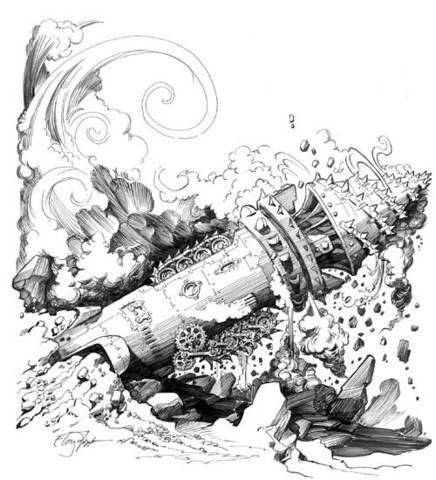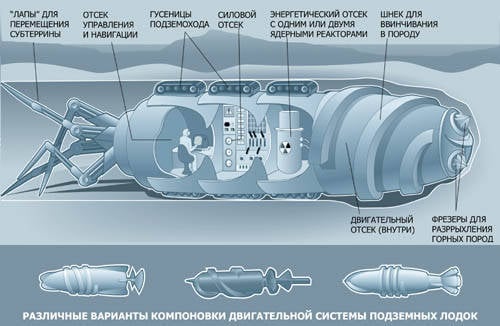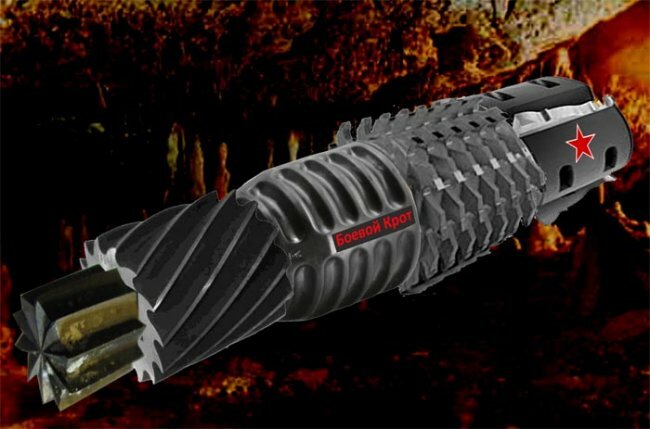Underground boats

One of the many myths about the secret technical equipment of the Third Reich states that there existed the development of combat underground tools under the code names “Subterrine” (project H. von Verne and R. Trebeletsky) and “Midgardschlange” (“Ritter's project).
The huge submarine on the second project consisted of several compartments having dimensions of 6 meters in length, 6.8 in width and 3.5 in height, with a total length from 400 to 524 meters. Weight - 60 thousand tons. There was a 14 electric motor with a 20 power of thousands of horsepower. Speed - under water 30 km / h, in the ground - from 2 to 10 km / h. Managed the vehicle crew in 30 people. Armament - mines and machine guns, underground torpedoes “Fafnir” (combat) and “Alberich” (reconnaissance). Auxiliary detachable means - projectiles for facilitating penetration in rocky soils “Mjolnir” and a small transport shuttle for communication with the surface “Laurin”.
At the end of the Second World War, galleries of unknown purpose were found near the town of Königsberg, and a nearby exploded construction of an unclear destination. There is a possibility that these were remnants of “Midgard Serpent” being developed as one of the incarnations “Weapons retaliation. "
Lost Subterin
For millennia, people dreamed of conquering the elements. Our long-time ancestors took the first steps in the development of the seas and oceans; watching the flight of birds - people wanted to get rid of gravity and learn to fly. And now, it would seem, today a man has fulfilled his dreams - high-speed ocean liners proudly cut through the waves of all the seas and oceans, nuclear submarines silently sneak into the water column, and the sky is streaked with inversion tracks of jet aircraft. Over the past 20 century, we even managed to overcome earth gravity, taking the first step into infinite space. All this is true, but humanity had another secret dream - to make a trip to the center of the Earth.

The underground world has always been for people something very mysterious, alluring and at the same time frightening. Mythology and religion of almost all nations, one way or another, is associated with the underground kingdom and the creatures that inhabit it. And if in ancient times the underground world was a forbidden place for man, then with the development of science and the emergence of the first hypotheses of the structure of the Earth, the idea of traveling to its center became more and more attractive. But how to do that?
Of course, this question could not help but worry science fiction writers and, while scientists were guessing about the device of the underworld, in 1864, Jules Verne finishes the novel Journey to the Center of the Earth, in which the main characters of his work, Professor Lindenbronn and his nephew Axel make a journey to the center of the earth through the mouth of the volcano. They travel by raft on the underground sea and return to the surface through the cave. It must be said that in those years the theory of the existence of vast cavities inside the Earth was popular, which, apparently, Jules Verne based on his novel. However, later scientists proved the inadequacy of the “hollow earth” hypothesis, and in 1883, the story of Count Shuzi “Underground Fire” was published. The heroes of his work, with the help of ordinary picks, pierce the superdeep mine into the zone of "underground fire". And although in the story “Underground Fire” no mechanisms were described, its author was already aware that the road to the center of the Earth must be made by man, and that there are no cavities through which you can travel deep underground. It is understandable, because the Earth's core is exposed to tremendous pressure and temperature, and from this it follows that there is no reason to talk about any “underground cavities”, and especially the existence of life in them.
In subsequent sci-fi works, descriptions of tools for penetrating the earth's firmament appear, much more perfect than the pick from the tale of Count Shuzi “Underground Fire. So, for example, in 1927, the science fiction novel by Count Alexei Nikolaevich Tolstoy, “Engineer Garin's Hyperboloid,” is released, in which engineer Garin, through his invention, a hyperboloid (thermal laser), pierces a multi-kilometer earth strata and reaches the mysterious olivine belt.
With the advancement of earth science and the development of technologies for laying deep drilling mines, the idea of a submarine, a kind of fantastic machine capable of moving in the midst of solid earth rocks, emerged. So, in Grigory Adamov's novel “The Winners of the Subsoil”, published by 1937, the author sent his heroes to the underworld on the underground, which was a massive rocket-like projectile. This fantastic machine had in the front of the drill bits and sharp knives made of heavy-duty metal and capable of crushing any rock in its path. His underground boat could move at speeds up to 10 km per hour.
It must be said that many science fiction works devoted to the topic of traveling to the center of the Earth have been created and are still being created, and if people used to travel to them in the depths of our planet by foot, then with the development of technology and science, underground travelers make their way much like modern submarines. The existence of such devices in real life is still in doubt, but there are some facts that suggest that people tried to design and build an underground boat more than once.
According to one version, primacy in the creation of underground shells belongs to the Soviet Union. Back in 30-ies, engineer A. Treblev, designers A. Kirilov and A. Baskin created the project of an underground boat. According to their plan, it was to be used as an underground oil producer - to go deep into the ground, to find deposits of oil, and to lay an oil pipeline there. The inventors took the structure of the living mole as a basis for the construction of the subway. Tests of the underground boat were held in the Urals in the mines under Mount Grace. With their cutters, roughly the same as those at coal-mining combines, the underground was destroying strong rocks, slowly moving forward. But the device turned out to be unreliable, often failed, and the project was declared untimely. However on this story The first pre-war development in our country does not end there. So it is known that the doctor of technical sciences P. I. Strakhov, who was the designer of underground tunneling machines, at the beginning of 1940 of the year, while he was busy building the Moscow metro, was summoned by D. F. Ustinov, the future people's commissar of the USSR. The conversation between them is more than interesting. Ustinov was interested in Strakhov, did he hear about the work of his colleague, engineer Treblev, who in 30-ies proposed the idea of an underground autonomous self-propelled vehicle? Strakhov was aware of these works, and he answered in the affirmative.
Then Ustinov said that there was a much more important and urgent task for him than the metro, - work on the creation of an underground self-propelled apparatus for the Red Army. According to Strakhov himself, he agreed to participate in this project. Unlimited funds and human resources were allocated to him, and after a year and a half, an experienced subway was passed acceptance tests. The autonomy of the underground boat was designed for a week, just so the driver should have enough oxygen, food and water. However, since the beginning of the war, Strakhov had to switch to building bunkers and the fate of the underground boat was unknown to him.
We should not forget about the numerous legends enveloping the super-weapon of the Third Reich. According to one of them, in Nazi Germany, there were projects of underground military vehicles under the code names "Subterrine" (project H. von Verne and R. Trebeletsky) and "Midgardschlange" ("Serpent Midgard", project Ritter).
The Midgardschlange subsurface was designed as a super-amphibian capable of moving on the ground, underground, and under water at a depth of 100 meters. The device was created as a combat universal vehicle and consisted of a large number of connected compartments having dimensions of 6 meters in length, 6.8 meters in width and 3.5 meters in height. The total length of the apparatus varied from 400 to 524 meters, depending on the tasks. The weight of this "underground cruiser" was 60 thousand tons. Under some assumptions, it began to be developed in the 1939 year. This combat vehicle had on board a large number of mines and small charges, 12 twin machine guns, Fafnir combat underground torpedoes and Alberich reconnaissance, a small transport shuttle for communication with the Laurin surface and detachable projectiles to assist in penetrating difficult ground areas Mjolnir. The crew consisted of a 30 man, the internal structure of the hull, resembled the layout of the compartments of the submarine (residential compartments, galley, radio room, etc.). 14 electric motors with a power of 20 thousands of horsepower and 12 additional engines with a capacity of 3 thousands of horsepower, were supposed to provide the “Midgard Snake” with maximum speed under water at 30 km / h, and underground - up to 10 km / h.
When World War II ended, near the town of Königsberg, adits of unknown origin were discovered, and near the remains of a blown-up structure, perhaps these are the remnants of the “Midgard Serpent” - a possible variant of the “Remedy Weapon” of the Third Reich.
There was another in Germany, another, less ambitious than the Midgard Serpent, but no less interesting project, besides it was started much earlier. The project was called “Sea Lion” (another name is “Subterrine”) and a patent for it was registered in 1933 by the German inventor Horner von Werner. According to the plan of von Werner, his underground vehicle was supposed to have a speed of up to 7 km / h, a crew of 5 people, carry a warhead of 300 kg and move both underground and under water. The invention itself was classified and archived. Perhaps he would never have been remembered if Earl von Staufenberg hadn’t accidentally stumbled upon it in 1940, moreover, Germany had developed Operation Sea Lion to invade the British Isles and an underground boat of the same name could be very useful . The idea was that an underground boat with saboteurs on board could cross the English Channel without hindrance and, having reached the island, quietly go under the English soil to the right place. However, these plans were not destined to come true. Luftwaffe chief Hermann Goering managed to convince Hitler that his aviation alone will be able to bring England to its knees. As a result, Operation Sea Lion was canceled, the project was forgotten, and Goering was never able to fulfill his promise.
In the 1945 year, after the victory over Nazi Germany, numerous "trophy teams" of former allies operated on its territory, and the project of the German underground boat Sea Lion fell into the hands of General SMERSH Abakumov. The project was sent for revision. Prof. G. I. Babat and G. I. Pokrovsky were studying the possibilities for developing the idea of a combat underground boat and came to the conclusion that these developments have a great future. Meanwhile, General Secretary Nikita Khrushchev, who replaced the deceased Stalin, personally expressed interest in the project. Scientists dealing with this problem already had their own groundwater, and the breakthrough of science in the field of nuclear energy brought the project to a new level of technological development - the creation of an atomic underground boat. For their mass production, the country urgently needed a plant, and in 1962, by order of Khrushchev in Ukraine, in the town of Hromovka, construction of a strategic plant for the production of underground boats was begun, and Khrushchev made a public promise "to get imperialists not only from outer space, but also from under the earth ". In 1964, the plant built and produced the first Soviet nuclear submarine, dubbed the “Battle Mole”. The underground boat had a titanium hull with a pointed nose and aft, with a diameter of 3,8 m and a length of 35 m. The crew consisted of a 5 man. In addition, she was able to take on another 15 man of the assault force and a ton of explosives. The main power plant, a nuclear reactor, allowed it to reach ground speed to 7 km / h. Its combat mission was to destroy the enemy’s underground command posts and missile mines. There were ideas about the possibility of delivering such "subterin", specially designed atomic submarines to the shores of the United States, in the area of California, where, as is known, earthquakes often occur. Then the “subterine” could establish an underground nuclear charge and, undermining it, cause an artificial earthquake, the consequences of which would be attributed to a natural disaster.
The first tests of the “Battle Mole” took place in the fall of 1964. The underground boat showed astounding results, passing through difficult ground “like a knife through butter” and destroying the underground bunker of the conventional enemy.
Later, tests continued in the Urals, in the Rostov region and in Nakhabino near Moscow ... However, during the next tests, an accident occurred that caused an explosion and an underground submarine with a crew, including paratroopers and the commander, Colonel Semyon Budnikov, remained forever walled in stone rocks of the Ural mountains. In connection with this incident, the tests were discontinued, and after Brezhnev came to power, the project was closed, and all materials were strictly classified.
In 1976, on the initiative of the Chief of the Central Administration Gostina Antonov, in the press, reports about this project began to slip, while the remnants of the underground nuclear ship itself, meanwhile, were rusting under the open sky before the 90s. Is the research and testing of underground boats in our time and if so, where? All this will remain a mystery, to which we are unlikely to receive a satisfactory answer in the foreseeable future. One thing is clear that man has only partially fulfilled the dream of traveling to the center of the Earth, and even if the “subterine” projects created by scientists cannot be compared with devices from science fiction works and capable of reaching the Earth core, yet humanity took its first timid step in mastering the underworld.


Information